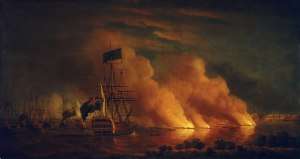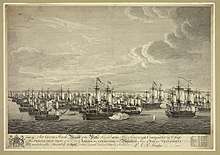HMS Stirling Castle (1742)
HMS Stirling Castle was a 70-gun third rate ship of the line of the Royal Navy, built at Chatham Dockyard to the 1733 proposals of the 1719 Establishment, and launched on 24 April 1742.[1]
 French Firerafts Attacking the British Fleet off Quebec, 28 June 1759 by Samuel Scott. The left foreground of the picture is taken up with the anchored British fleet in which Saunders' flagship, Stirling Castle, is in starboard-quarter view in the foreground just left of centre. | |
| History | |
|---|---|
| Name: | HMS Stirling Castle |
| Ordered: | 6 August 1739 |
| Builder: | Chatham Dockyard |
| Launched: | 24 April 1742 |
| Fate: | Scuttled on 14 September 1762 |
| Notes: |
|
| General characteristics [1] | |
| Class and type: | 1733 proposals 70-gun third rate ship of the line |
| Tons burthen: | 1225 |
| Length: | 151 ft (46.0 m) (gundeck) |
| Beam: | 43 ft 5 in (13.2 m) |
| Depth of hold: | 17 ft 9 in (5.4 m) |
| Propulsion: | Sails |
| Sail plan: | Full rigged ship |
| Armament: |
|
Whilst under the command of Captain Thomas Cooper, Stirling Castle took part in the Battle of Toulon on 11 February 1744. Stirling Castle was the lead ship in Rear-Admiral William Rowley's van division of Admiral Thomas Mathews' fleet that engaged the France-Spanish fleet. After the battle several officers were court-martialed, including Captain Cooper who appeared on 12 May at Port Mahon, where he was dismissed the service. He was immediately restored to his former rank and command however, as the charges against him were not deemed detrimental to either his professional honour or his ability as a sea officer.[2]
On 15 April 1746, Stirling Castle captured the 24-gun frigate Volage. However, Oriflamme recaptured her the day after.[3]
She took part in the Battle of Havana in 1762.[4] Shortly afterwards Stirling Castle was declared unserviceable and was stripped and scuttled in the upper reaches of Havana harbour on 14 September 1762, on the orders of Admiral George Pocock.[4]

Notes
- Lavery, Ships of the Line vol.1, p171.
- Ships of the Old Navy, Stirling Castle.
- Roche (2005), p. 473, volume 1.
- Winfield. British Warships. p. 49.
References
- Lavery, Brian (2003) The Ship of the Line - Volume 1: The development of the battlefleet 1650-1850. Conway Maritime Press. ISBN 0-85177-252-8.
- Michael Phillips. Stirling Castle (70) (1742). Michael Phillips' Ships of the Old Navy. Retrieved 9 August 2008.
- Roche, Jean-Michel (2005). Dictionnaire des bâtiments de la flotte de guerre française de Colbert à nos jours. 1. Group Retozel-Maury Millau. pp. 372–373. ISBN 978-2-9525917-0-6. OCLC 165892922.
- Winfield, Rif (2007). British Warships of the Age of Sail 1714–1792: Design, Construction, Careers and Fates. Seaforth. ISBN 1-86176-295-X.